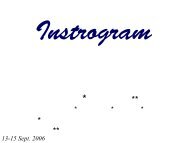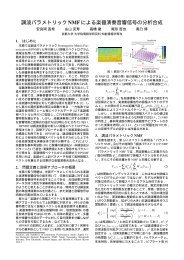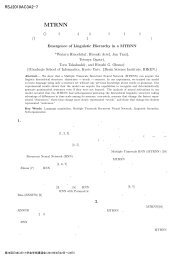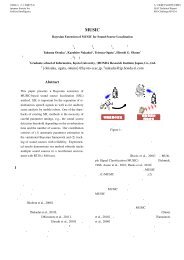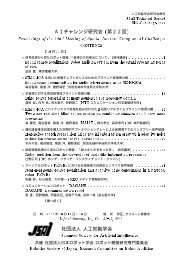ロボットにおける自己身体の順逆モデルを 再利用した他者 ... - 奥乃研究室
ロボットにおける自己身体の順逆モデルを 再利用した他者 ... - 奥乃研究室
ロボットにおける自己身体の順逆モデルを 再利用した他者 ... - 奥乃研究室
Create successful ePaper yourself
Turn your PDF publications into a flip-book with our unique Google optimized e-Paper software.
RJ2008J04業 を 大 幅 に 効 率 化 できる. 連 想 された 予 測 画 像 系 列と 各 静 止 画 像 を 比 較 する.5.3.2 実 験 結 果上 記 手 法 により 計 算 した 誤 差 をPB 空 間 に 対 応 させた 結 果 をグレースケールで 示 した(Fig. 6). 予 測 誤差 が 最 小 となったPB 値 には× 印 を 付 した.静 止 画 像 1~4については 動 作 系 列 が 適 切 に 認 識 されていることが 確 認 できる.また 動 作 初 期 画 像 については,PB 空 間 全 体 において 予 測 誤 差 が 一 様 となり,動 作 が 一 意 に 同 定 できないことも 確 認 できる.11実 験 の 結 果 ,ロボットは 提 案 モデルにより 人 間 からの 任 意 方 向 からの 提 示 動 作 を 認 識 , 視 点 変 換 を 施して 模 倣 を 行 うことが 可 能 であることを 確 認 した.Motion 1(Move from Left to Right)Motion 2(counterclockwise rotation)PB2PB20.80.60.40.2×00 0.2 0.4 0.6PB10.8 1Motion 1(Move from Left to Right)10.80.60.40.200 0.2 0.4 0.6PB10.8 1Motion 3(Move forward)1×PB2PB20.80.60.40.2×00 0.2 0.4 0.6PB10.8 1Motion 2(counterclockwise rotation)10.80.60.40.2×00 0.2 0.4 0.6PB10.8 1Motion 4(clockwise rotation)Figure 7Motion 3(Move forward)Motion 4(clockwise rotation)●:Start Point, ▲: End Point, ◇: Static ImageAssociated Motion Trajectories from a Static Camera Imageさらに 人 工 神 経 回 路 モデルの 連 想 機 能 ( 予 測 誤 差 )を 活 用 することで, 本 手 法 が 適 用 可 能 な 動 作 の 判 定( 既 知 動 作 と 未 知 動 作 の 識 別 )が 可 能 であること,さらに 動 作 中 の 静 止 画 像 から, 全 体 の 動 作 を 効 率 よく 連 想 可 能 であることを 確 認 した.今 後 は, 視 点 変 換 による 物 体 操 作 の 模 倣 ( 三 項 関係 )だけでなく, 身 体 情 報 変 換 を 利 用 したより 高 度な 模 倣 (mimic)を 実 現 していく.さらに 文 脈 情 報 変換 についても 検 討 し,コミュニケーション 研 究 を 展開 していく 予 定 である.PB20.80.60.40.2×00 0.2 0.4 0.6 0.8 1PB1Initial PositionFigure 6 Difference Maps between Observed and Associated Motionsfrom Static Camera Images予 測 誤 差 が 最 小 となったPBにより 連 想 した 物 体 軌道 ( 物 体 色 領 域 のカメラ 内 重 心 座 標 )をFig. 7に 示 す.各 静 止 画 像 を 通 過 する 動 作 が 連 想 できていることが確 認 できる.6. まとめ本 稿 では, 外 部 の 動 的 対 象 の 適 応 ( 予 測 ・ 模 倣 )のために, 自 己 の 順 逆 モデルを 転 用 するという 概 念を 示 した. 具 体 的 には,“ 物 体 操 作 を 介 した 模 倣 ( 三項 関 係 )”さらに“ 親 による 幼 児 の 模 倣 ”を 仮 定 し,模 倣 能 力 の 発 達 プロセスをモデル 化 した.これを 人工 神 経 回 路 モデルと 実 ロボットにより 実 装 した.謝 辞 本 研 究 は, 科 研 費 若 手 A, 科 研 費 基 盤 S, 栢 森財 団 10 周 年 記 念 特 別 研 究 助 費 の 支 援 を 受 けた.参 考 文 献[1] Y. Demiris and G. Hayes: Imitation as a dual-route process featuringpredictive and learning components: a biologically-plausiblecomputational model, Dautenhahn and Nehaniv (Eds.), “Imitationinq Animals and Artifacts”, MIT Press, chapter 13, pp. 327–361,2002.[2] T. Makino and K. Aihara: Self-observation Principle for Estimatingthe Other’s Internal State, Mathematical Engineering TechnicalReports METR 2003-36, the University of Tokyo, 2003.[3] C. Trevarthen and P. Hubley: Secondary intersubjectivity: Confidence,confiding and acts of meaning in the first year, Lock,A.(Eds.), Action, gesture, and symbol: The emergence of language,New York: Academic Press, pp. 183–229, 1978.[4] S. Jones: Infants Learn to Imitate by Being Imitated, Proceedings ofIEEE/RSJ International Conference on Development and Learning(ICDL-2006), 2006.[5] J. Tani and M. Ito, “Self-Organization of Behavioural Primitives asMultiple Attractor Dynamics: A Robot Experiment,” IEEE Transactionson SMC Part A, Vol. 33, No. 4, pp. 481-488, 2003.[6] J. Tani and S. Nolfi: Learning to perceive the world as articulated:an approach for hierarchical learning in sensory-motor systems,Neural Networks, Vol. 12, No. 7, pp.1131-1141, 1998.[7] T. Miyashita, T. Tajika, K. Shinozawa, H. Ishiguro, K. Kogure andN. Hagita, "Human Position and Posture Detection based on TactileInformation of the Whole Body," IEEE/RSJ IROS 2004 Work Shop,2004.26 日 本 ロッ 術 講 (2008 年 日 〜 日





